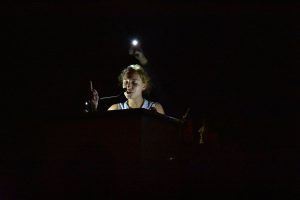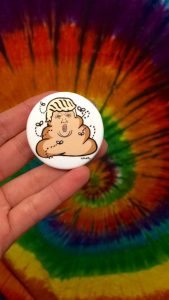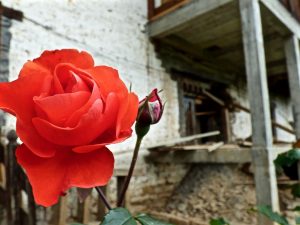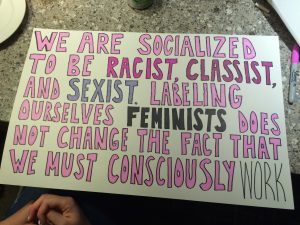Author Archives: Devin Domeyer
Liz Wagner – PA Farmer (rough cut)
Editing this down to under 4 minutes was extremely frustrating. I took ~ 3 hours of footage and she just talked about so many things! My interest in the subject matter made me lead her in weird tangents though. And she really could talk — she never left much time in between sentences. That’s how I talk too, so we interrupted each other happily for 3 hours. When I got home to edit I realized how unhelpful that is. I think the overall choice to film her the entire time was positive though. It was a boar to wade through but I pulled some nice shots from it. Liz is one of the Lehigh Valley farmers that sells at the Muhlenberg Farmers Market so that’s how I met her. After I contacted her she recommended we go to Crooked Row, her farm off to the side of her parents’ larger farming operation. Her parents also own bison which is ridiculously cool. We fed them apples — definitely the most interesting thing I’ve done on a Sunday morning this semester. Liz’s friend was visiting so she brought him along and I tried to edit around him.
Interview Pitch
I will be interviewing Liz Wagner: she owns Crooked Row Farms in the Lehigh Valley. I met her at a Farmer’s Market I started at Muhlenberg College and I realized she has great stories to tell about the challenges of farming in modern day America. She farms for Community Supported Agriculture which I thought would be a way to flesh out the interview: her perspectives on farmer’s markets, agriculture education in cities of the Lehigh Valley, etc. She also has opinions on the progressive of farming legislation in America which I thought would be a nice direction for the interview to end at.
I have been studying sustainable agricultural practices for a while now at college and am interested in picking her brain about the process of becoming organically certified and the economic and community benefits supported by farmers markets and CSAs. I should be interviewing her on Thursday of this week.
B-roll:
I’ll be interviewing her (and maybe her boyfriend who runs a kombucha brewery) at her farm. So B – roll will be shots of the farm, shots of her gardening/farming, shots of the surrounding scenery (roads, cars, urban/suburban farming) and shots of the kombucha process if available.
documentary as social discourse
I’ve been thinking about the role documentaries play in shaping important conversations. I was listening to Serial from NPR in my car and wondering if a criminal case was reopened on public airwaves, would it make a difference? Or, would this man stay in prison without a retrial? I had read A History of Documentary Film earlier and remembered a section on films that shape social discourse. (I had to re-read it for examples) Filmmaker Stanley Nelson made films that exposed under-represented issues in popular culture. His film The Murder of Emmett Till reopened an inquiry into the brutal murder of 14 y/o Emmett Till in 1955. The Paradise Lost trilogy created public support for the release of the “West Memphis Three”, falsely accused of the murder of three young boys. The directors of Paradise Lost, Joe Berlinger and Bruce Sinofsky are excellent examples of filmmakers who allowed their film to evolve from a story about poverty and the legal system into an investigation using cameras. This evolution was also noted by Errol Morris who said “I investigated a murder with a camera – an oddity in and of itself, it was not telling a story about a murder investigation, it was the investigation – and evidence was accumulated with that camera.” I googled an update on Adnan Syed (the prisoner in Serial) and he’s been granted a retrial.
“The Above”- KJ
What are the ethics of surveillance? And who is being surveyed? These are some questions I was left with after watching Kirsten Johnson’s film “The Above”. A second viewing was helpful; at the end KJ included the U.S. Army 1st Brigade After Action Report: they recommended keeping a surveillance blimp flown above Kabul at all times, even if the camera was broken. People act different when they believe they’re being watched. KJ’s use of this statement only at the end of the film reminded me of something she said to us last week. In her filmmaking, she said she doesn’t like telling the audience what to think/feel. Rather, she hopes they learn how to watch a film during the viewing. I felt she employed that technique with “The Above”. I discovered how I felt watching the surveillance blimp as KJ showed me just how many places it reached and just how mundane its footage must be. Mostly people living their ordinary lives; or at least as ordinary as possible under constant surveillance. It almost reminds me of 1984– Big Brother is always watching. And that mantra is most effective as a ever-present feeling: something that doesn’t necessarily need technological follow-through. KJ allowed viewers of “The Above” to relate to that feeling by putting us mostly in a position of looking up at the balloon, on the ground with the people of Kabul. Going a step further, she showed us what it would look like in suburban America. Asking us to fully relate to a feeling of being watched.
What is documentary?
I was just sitting on my porch, describing the movie Kid Cannabis (a must watch) to my friend. She asked me “is it a documentary?” and I told her “no, just a recreation of real events.” Then I remembered what Betsy McLane writes about Robert and Frances Flaherty, influential documentarians in the mid-1900s. First, she recognizes their work as the basis of documentary conversation on “truth, reality and illusion”. Then, she goes on to say his famous films “Nanook of the North” and “Moana” were staged, with actors representing historic cultures in Northern Quebec and Somoa. Flaherty is a celebrated documentarian but his most prominent work was staged. Is this documentary film? Clearly, my subconscious still thinks it has to be “real events” with real people, not actors. I mean, McLane says Robert Flaherty depicted Eskimo and Somoan culture only to the extent of family, imposing a “nuclear family structure along conventional Western cultural lines.” Is this documentary? Even if it isn’t, Flaherty definitely shaped the history of documentary film.
Some ways to think about documentary
Being new to documentary, my original impressions were simple. It’s non-fiction, relatable, and doesn’t include “actors” just “real” people. This chapter expanded up my understanding. It also gave my disparate impressions some structure: “the form of documentary is mainly determined by subject, purpose and approach.” It also became clear that this structure is not a firm one. Documentary allows for interpretation in all areas, with experimental documentary as the most avant-guard. One such experimentation is the use of imagery and “beauty”. McLane writes that “beauty is functional”. From what I can interpret, she is implying that in documentary, scenery and beauty are used to communicate feeling or enhance information, rather than to create beauty for the sake of beauty. I find this a very fine line that I would like to explore. This connects to her comment that “documentary is purposive”, with the intention of achieving something. All this has expanded my understanding of documentary as an art-form.
We are Laura and Devin. This is our project. Our first task was deciding what to record. This meant deciphering what each of the audio prompts was asking for. The one we struggled with the most was the made-world because the human and non-human world seemed fairly straightforward. What does the “made-world” entail? Clearly it must be something different from the human and non-human world. We decided the made-world is a world that is created by humans and would not have existed without us. It is able to function without human stimulus. The fountain was built and implemented into Muhlenberg’s campus by someone, but it stands alone and produces its own sound.
We took out both the zoom voice recorder and the Tascam recorder so we could decided which one we preferred. We ended up recording our sounds using the zoom voice recorder. It was fairly easy. We messed with the input volume setting to try to capture more sound, especially when recording the non-human world (wildlife). After we recorded everything we connected and uploaded the media to Devin’s macbook using the usb connecter. We realized we needed to export the media from Quicktime (wav) to m4p to get it on the blog. Hope it worked!
Bad audio explanation:
Bad audio:
Human world (coffee steamer):
Made world (fountain):
Non-human world (wildlife):
5 photo story





Me as a documentarian
I document important life events like weddings, vacations, graduations, new dogs and new apartments. I always feel its necessary for me to capture the details of these events on camera, so my future self can be nostalgic. I have a horrible memory, so when I find myself wanting to look through old photographs or videos, what stands out to me are the ordinary moments. Weddings and vacations are easy to picture in my mind because the images have emotional weight, making them harder to forget. The random pictures I’ve collected of family and friends, particularly beautiful streets, and a million other everyday items that in the moment seemed picture-worthy, make up the ordinary bulk of my life. These images are often the most interesting to look at try to remember. I think that’s why letters, postcards, newspapers and family photos always interest me most in museums. I like imagining the ordinary life of people who’s world looks/looked completely different than mine. When I travel I like to make movies out of clips I’ve taken throughout the trip. That way I can remember still images, but also better imagine the sounds and movement of a place. I did this during my abroad semester in Bhutan and my following trip to Vietnam. These videos have allowed me to relive some of the best moments of my life.
